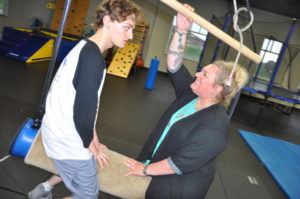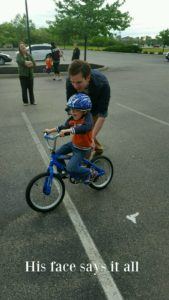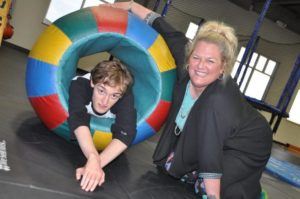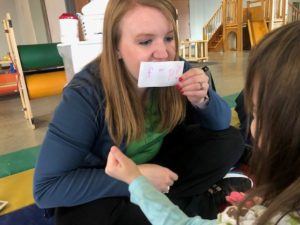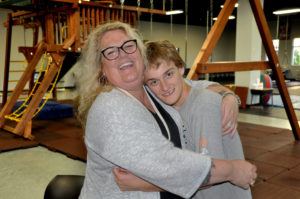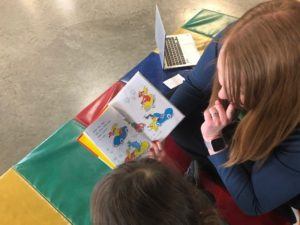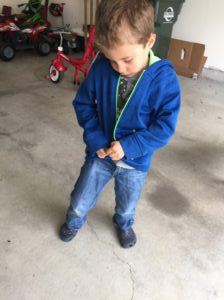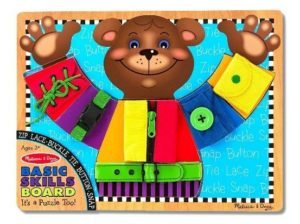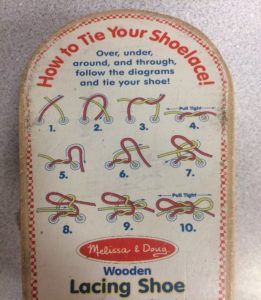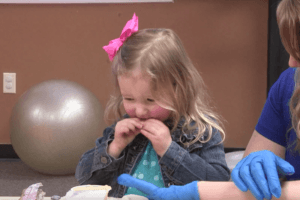Blog
 I wrote the following in February 2005 when Jakob was three-and-a-half…
I wrote the following in February 2005 when Jakob was three-and-a-half…
“We got the results of Jakob’s ADOS yesterday and they weren’t what I was expecting. I really believed he would test on the autism spectrum but he didn’t. It was autism. The label is autism. To put it in perspective, his score could’ve been 0-22 with 0 being no autistic characteristics. A score of 7-12 would have been autism spectrum disorder. Jakob scored a 16. Autism.
For the first few hours after we heard that word, I felt like I was having an out-of-body experience. Thoughts were racing through my head at 100 miles-an-hour…What do I do next? What happens when we get old? What happens to Jakob when we die? Will he ever talk? Should I have another baby so he won’t be alone? What if we have another baby and he/she is autistic too? Or has something else wrong? How do we afford more therapy? What haven’t we tried to do to help him? What does he understand…does he know how much we love him? This must be my fault…what did I do to cause this? What did his dad do? Was it his vaccinations? How do I tell my family? Will they understand…will Jakob ever understand??? How will other kids treat him? HOW DO I FIX THIS???”
Reading that takes me back to the place I was in that day and I remember those feelings so clearly. Partly because they return every now and then in new and different ways. The uncertainty, the wondering, the frustration, the fear. It’s all just a part of the party, I suppose.
The big difference now is I’ve learned how to not wallow in the pain and suffering that comes with all that fear. I’ve figured out that the fear is all in my head. It’s not real. It’s all imagined. When I look at Jakob and I’m experiencing any kind of stress or discomfort about his health and well-being or his future, I ask myself one simple question, “Other than what I’m thinking and believing right now, is he ok? Am I ok?”
And so far, every single time I’ve asked that question, the answer has been that we’re both ok. Better than ok, actually, he’s happy, and for the most part, he’s healthy. For the parts that aren’t so healthy, we see some great doctors, we’re managing his symptoms and healing his system. He continues to learn and progress and he’s developed a passion for trying new things. He has so many people who love him.
Then I remind myself that I believe the universe is benevolent and that the purest of heart will always be taken care of. That one belief eases any and all concerns that may arise in me. It’s faith. It’s a knowing. It’s a matter of letting go of all the worry and being in the moment and just loving it all. What a journey. What a kid. What a life. It’s all just how it’s supposed to be. There’s nothing for me to fix. It’s all perfect.
Read MoreLarge Motor:
Bike or scooter riding
Jump rope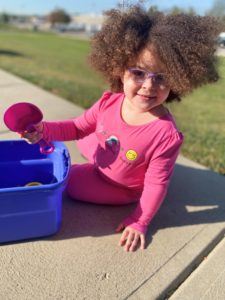
Throw, kick and catch a ball
Hit a ball with a racket or bat
Swim
Hike
Outdoor sports like kick ball, baseball, soccer
Follow a line of sidewalk chalk along a jagged and curved path.
Water balloon toss or water balloon baseball
Hopscotch
Small motor, Sensory and Motor Planning:
Sidewalk chalk
Scavenger hunt outside (find something: rough, smooth, green, pink, on top, under etc)
Obstacle course outside
Swim for balls or diving toys with sight words
Fill spray bottles with liquid watercolors, spray on easel outside with watercolor paper.
“Paint” with water, get out the old paintbrushes, paint rollers and mops along with a bucket of water and have the kids “clean” or “paint” the deck or pavement.
Paint rocks or a flower pot for the garden
Catch fireflies
Pick flowers
Make paper airplanes
Make ice cream or popsicles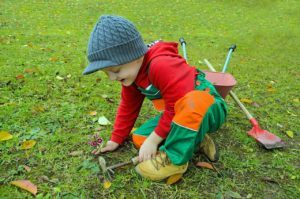
Play I-Spy on road trips
Leaf rubbing
Plant flowers
Make a windsock
Language:
Swim for balls or diving toys with speech words on them
Name items that start with certain letters or sounds while taking a walk
Talk about what is on top/under/next to while running errands
Ask Who, What, When, Where questions
Describe items outside or on road trips
If you have concerns about your child’s development, go to http://checklist.abcpediatrictherapy.com and fill out this checklist about your child. You will receive tips and tricks on how you can help your child. You will also find much information at https://www.abcpediatrictherapy.com.
Read More
 My first vacation with Jakob was a 22-hour road trip from Tampa to my parents’ house in Central Illinois. Jakob was 10 months old and already showing some signs that there might be something going on that made him “different.” He was pretty good in the car as long as he had his little yellow toy telephone in his hands and he was hitting the same buttons over and over to make the same series of beeps play. Over and over and over again. Non-stop, every minute we were in the car. He didn’t sleep and would cry if he dropped the phone. Which happened frequently. We were driving a Nissan Maxima and I couldn’t always reach around to find the phone for him so we made a lot of stops to retrieve it.
My first vacation with Jakob was a 22-hour road trip from Tampa to my parents’ house in Central Illinois. Jakob was 10 months old and already showing some signs that there might be something going on that made him “different.” He was pretty good in the car as long as he had his little yellow toy telephone in his hands and he was hitting the same buttons over and over to make the same series of beeps play. Over and over and over again. Non-stop, every minute we were in the car. He didn’t sleep and would cry if he dropped the phone. Which happened frequently. We were driving a Nissan Maxima and I couldn’t always reach around to find the phone for him so we made a lot of stops to retrieve it.
Exhausted by the end of the first travel day, we looked forward to some rest when we stopped at a hotel for the night. Thinking Jakob would finally sleep, we set up the pack and play. That turned out to be a big fat no-go. Wide awake and ready to party, he spent the majority of the night sitting up between us on the bed in the dark, laughing, kicking, crying and playing with his phone. No one slept much. The second day in the car, it was the same story but with a twist. By the time we reached my parents’ house, his lips and mouth were covered in this thick white creamy stuff. Thrush. A trip to my parents’ family doctor and some medication that made his entire mouth blue took care of that. On the trip back home to Tampa, we didn’t bother to stop at a hotel since we knew no one was going to sleep. We drove the 22+ hours home straight through mostly in silence except for the beeping of that phone.
I’ve taken Jakob on a lot of road trips since that first long, tiring adventure and it sure has gotten a lot easier. He still loves to ride in the car but that little yellow phone is gone. He gets so excited to stay at the “Hampton Inn House” and has the biggest grin on his face when he finds out the room number we’re staying in. He has no problem sleeping. He doesn’t eat any foods from restaurants so I always have to pack his meals. So if it’s more than one day in the car, we really need a suite at the hotel to make all the food prep easier. I make sure he has something to do that he enjoys like a color or sticker by number book or his iPad. The more activities, the better. I always double check that we have more than enough pairs of socks and underwear since he wants one fresh set in the morning and another at night. I take his toaster because we can’t put his waffles in one that has had anything with gluten in it. He is gluten and casein free and can have a reaction even if it only touches something he eats. Even though at this point I believe he’d do fine on a plane, there’s just too much we have to pack including groceries. And that damn toaster. Plus, he loves seeing the routes and roads that he’s been studying on his iPod and atlases and I wouldn’t want him to miss all the detours and potholes along the way.
For me, a vacation needs to be relaxing. If I have a kid who’s stressed, frustrated, tired, scared, angry or anxious, that’s not relaxing for anybody. So on any trip, I take with him, my main priority is his comfort level. I’m not going to take him somewhere that’s going to be overwhelming for him until he’s ready for it and is excited to go. Jakob is turning 17 this fall and we’re going to Sesame Place. He’s beyond thrilled and talks about it every day. I’m pumped knowing that we’re both going to have a ball. It’s perfect timing for us, and I personally can’t wait to meet Cookie Monster. He’s my favorite.
Read MoreHelp your child be comfortable separating from mom and dad: Expose your child to other people early on and consistently. Have grandparents, good friends, babysitters/daycare providers watch your child even for a short time of the day. It’s healthy for babies/toddlers to go through some separation anxiety as this tells you that they recognize mom and dad. However, the exposure to trusting other adults and being comfortable without mom and dad helps your child build confidence and trust in various environments and with and without their parents present.
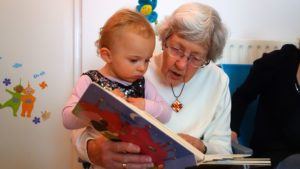
Following another adult’s directions: Teaching your child that they need to listen to you and other adults will help them learn to respect others and will help them to know to listen to their teacher and follow through with assignments as they get older. Following directions will be a big part of their school day; “throw your tissue away, put the crayons in the cup, put your coat on” these will all be frequent directions they will hear and need to follow.
Sitting in a group for Circle Time: In Circle Time, children will be expected to sit, listen to a book, talk about the weather and the day of the week. Parents can prepare their child for this by reading aloud and talking with them about the day so they have practice listening and engaging in conversations.
Working in small groups at Centers: Staying at a Center for 5-10 minutes will take some attention span and working next to their peers will take some parallel play, turn taking and sharing. You can model these behaviors when you play with your child! If you have friends with children about the same age you can set up a play date so they can practice these skills with peers they already know. The more children play, the more creativity and problem solving they will develop.
Being respectful of others: Demonstrating how to treat and talk to others will help your child learn how to be respectful of others and how others should treat them in return.
Learning to get along with peers: Until they are 3 1/2 years old, children will participate in parallel play where they play near each other. Associative play occurs until 4 1/2 when they trade and share toys. At home, you can practice trading, sharing, taking turns with games, pretend play and simple toys.
Learning numbers, counting, letters, recognize their name, shapes, colors: Using books and toys, you can talk to your child about colors, shapes and counting, “Let’s count how many bunnies are on the page!” When playing with toys, talk about the color the toy is, “we’re throwing the red ball!” In the car, listen to the Alphabet Song and songs about counting to make learning fun. Have magnetic letters on the refrigerator, put their name up in their room! When helping your child get dressed, talk about the color shirt/pants they have on, the more you build these facts into their daily vocabulary, the more these skills will come naturally.
Social emotional skills: Talk about feelings, express feelings and demonstrate how to handle frustrations in a healthy way. Setting consistent limits and rules will help kids learn what is expected. Teaching empathy will allow your child to be a good friend to others as well. Recognizing their feelings and guiding them through handling their emotions will minimize meltdowns and help them handle frustrations in a healthy way.
If your child needs help with any of the above skills to be ready for preschool, we want to help! Go to https://www.abcpediatrictherapy.com for more tips on how to help your child.
Read MoreIf your child has a speech disorder, he or she might be able to qualify for financial aid. The Social Security Administration (SSA) offers disability benefits to people of all ages who are unable to work, or in your child’s case, participate in typical childhood activities due to a disability. Speech disorders alone will not qualify, but depending on the cause of your child’s speech disorder, he or she may be eligible.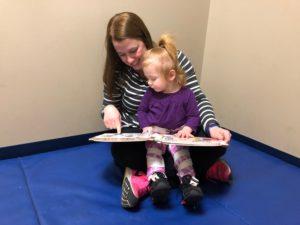
Technically Qualifying for Social Security
All children are eligible for Supplemental Security Income, or SSI benefits. SSI is only awarded to families with a severe financial need. This means that if you or your spouse earns a decent wage, you will not be eligible for disability benefits. The larger your family, the higher your monthly income limit will be.
For example, if you’re a single parent and you have one child, you cannot earn more than $38,000 before taxes in 2018 and still qualify for SSI. If you are a two-parent household of five, you could earn a little over $55,000 and still qualify. You can view a chart on the SSA’s website to determine how much your unique family could make while still qualifying.
Unfortunately, most children are denied SSI benefits due to household income limits. The good news is once your child turns 18, your income will no longer against your child, even if he or she still lives at home.
Medically Qualifying With a Speech Impairment
All conditions that qualify for disability benefits can be found in the Blue Book, the SSA’s manual of qualification criteria. There is a separate version of the Blue Book for both children and adults. Children do not qualify for a speech disorder alone, so this means that if your child has no other diagnoses or disabilities, he or she will unfortunately not qualify for disability benefits due to an inability to speak.
If your child’s speech impairment is cause by another condition, he or she may be eligible. There are many qualifying conditions listed in the Blue Book, but some conditions that often qualify include:
Autism
Autism can be found in Section 112.10 of the Blue Book. Under this listing, your child will qualify if he or she has measurable difficulty in any form of communication (verbal, nonverbal, social interaction) and has severely limited interests or participates in repetitive patterns of behavior. Children with autism will also need to have medical evidence proving severe difficulty with one of the following areas of physical functioning:
- Understanding and remembering information
- Interacting with others (playing with children, following adults’ instructions)
- Concentrating and accomplishing tasks
- “Adapting oneself,” which means controlling emotions in a school setting
Down syndrome, on the other hand, will automatically medically qualify with a karyotype analysis. The only exception is if your child has Mosaic Down syndrome (2% of the Down syndrome population), which often has less severe health and intellectual complications will need a little more medical evidence.
The en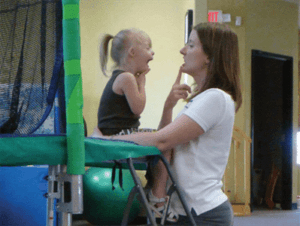 tire Blue Book can be found online so you can review the listings with your pediatrician to see if your child qualifies.
tire Blue Book can be found online so you can review the listings with your pediatrician to see if your child qualifies.
Starting Your Application
Before applying, you should always review the Child Disability Starter Kit to get a list of all documents needed before officially applying. You’ll have to apply for SSI benefits in person at your local SSA office. Your child does not have to be present for the application process. To schedule an appointment to apply in person, call the SSA toll free at 1-800-772-1213.
Helpful Resources:
Household SSI Limits: https://www.ssa.gov/ssi/text-child-ussi.htm
Childhood Blue Book: https://www.ssa.gov/disability/professionals/bluebook/ChildhoodListings.htm?PHPSESSID=2e1852cec574b204c1062189dbe882f2
Local SSA Office: https://www.disability-benefits-help.org/social-security-disability-locations
Child Disability Starter Kit: https://www.ssa.gov/disability/disability_starter_kits_child_eng.htm
Provided to ABC Pediatric Therapy Network, https://www.abcpediatrictherapy.com by:
Deanna Power
Director of Outreach
Disability Benefits Help
Read More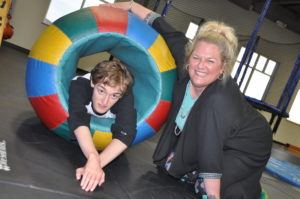 In so many ways, the beginning of this journey with Jakob felt like a one-woman war against time and “the man” who was trying to keep us all down. Of course, that wasn’t the case, but you would have been hard-pressed to convince me otherwise at the time.
In so many ways, the beginning of this journey with Jakob felt like a one-woman war against time and “the man” who was trying to keep us all down. Of course, that wasn’t the case, but you would have been hard-pressed to convince me otherwise at the time.
The hopeless future that was being presented to me, the obvious frustration and discomfort that Jakob was feeling, my sheer exhaustion from Jakob only sleeping three hours a night was just the beginning. Then there was the incredible amount of information to sift through to find the cause of all the symptoms and the best treatments for them. And then the pushback from mainstream medical when I made choices they didn’t agree with.
No one understood. Nobody got it. No one could relate. Unless they too were going through it.
Back then, I didn’t know anyone else who was experiencing a brand new autism diagnosis. I didn’t have another autism mom to talk to, share ideas with or cry to. I would try to have conversations with my friends, family, and co-workers, but they never went too far. I’d tell them what was going on in my house, and I heard a lot of “it’ll get better,” but that was about it. I really think they thought I was exaggerating or being overly dramatic. Or, maybe I was just making excuses for being late or not getting a project done or not making that phone call or seeming like I really didn’t care about them or my job. They didn’t understand, but how could they?
My pain, my fear, and my guilt were so all-consuming that it was impossible for me to just get through the day without self-medicating with wine, cigarettes, food and other things. I can remember someone saying to me that if I kept it up I was going to kill myself and I said I didn’t care. And I meant it.
And then I found “my people.” Through Jakob’s therapists, I was introduced to other moms like me who were thinking, feeling and believing the same things that I was. I realized I wasn’t quite as crazy as I thought. I no longer felt alone. They got it. They got me. And most importantly, they got Jakob.
I was able to take Jakob to their house and it was OK if he broke a lamp or peed on the wall (neither of which he did, but if he would have it would have been OK). He could tantrum non-stop for two-hours, and they were unfazed and knew exactly what to do to help me. I could be in any mood I wanted – pissed, distraught, exhausted, hopeless and it would be OK.
I don’t think I would have made it through the early years without those ladies, many of whom I still consider my dearest of friends 13-years later. After all our kids have been through, they still get it, they still get me, and they still get Jakob. Acceptance, non-judgmental and unconditional love – the trifecta that has made total strangers connected through a diagnosis, my family.
So if you’re a mom and you feel like you’re fighting a one-woman war, it’s going to be ok. Your tribe is out there. Go find your new extended family, share your failures and triumphs with those who get it. It will get better. A lot better. I promise.
Read More For the past couple months, Jakob and I have been having discussions about what he would like to do this summer. He has a few trips planned, one to see his family in New York, one to see my parents in Illinois and then one to see his biomedical doctor in upstate New York.
For the past couple months, Jakob and I have been having discussions about what he would like to do this summer. He has a few trips planned, one to see his family in New York, one to see my parents in Illinois and then one to see his biomedical doctor in upstate New York.
On our way to see Dr. Bock, we’re going to stop at Sesame Place in Pennsylvania for a day or two, and he’s super pumped. And I’ll be honest, I think I might be as excited as he is. Sesame Street for me is a league of its own. It’s not Blue’s Clues, Barney or any of the shows that were big when he was little. It can easily be appreciated by kids of all ages. My mother who is 77 still loves to watch it with us. I mean, seriously can you beat Cookie Monster, Grover, and Oscar? I think not.
Between those three road trips, we have approximately 20 days of summer break taken care of. Figuring out what to do with the other 70 has been the bane of my existence for the past three months (I’m being only slightly dramatic).
If he were a typical kid, it would be no big deal. A Gold Pass to King’s Island, a driver’s license and a car would take care of it. But what we need to take into consideration is a little more complicated than wondering if I have good enough car insurance.
Will he be able to keep his regular therapy schedule? Are there camps that work around his therapy schedule? What camps are there? Who’s running them? What are their qualifications? Are they camps that just keep him entertained or do they actually work on the goals in his IEP? Is there anyone working at these camps who are already familiar with Jakob? Will the people there be patient enough to take the time to figure out what Jakob is trying to tell them? How do we get him there and who’s going to pick him up? Will he have fun? Do they do things he enjoys? Will he be safe? How close of an eye will they keep on him? What are the options for days and hours? Are all the good camps already filled up? How much is it going to cost? Is it worth it? Do I even really want to send him to camp?
Maneuvering it all requires calm contemplation and a focus on what it is I want Jakob to get out of this three-month break from his high school for kids on the spectrum that he loves so much. I want him to be happy, healthy and safe. Those are always the top priority. I want him to have fun. For Jakob, that means doing something he enjoys with people he likes and being met where he’s at. He needs to feel heard and understood, respected and celebrated. And I would love for him to continue loving to learn how to communicate more clearly and make new friends and interact with them.
For us, that means summer break is filled with horseback riding, music camp, swimming, plenty of arts and crafts, Saturday night parties at the house with all his friends and plenty of speech and occupational therapies.
The pressure on special needs parents surrounding summer programming is intense. We know our kids are behind their peers. In some cases, far behind. We know how hard they work all year long and the thought of putting them through that in the summer too is painful. We want our kids to just be able to be kids. And we also know that if they’re left to their own devices, they will likely grab their iPads, PlayStations or DVD collections, and that will be it.
I believe there is a happy medium. Focus, make fun a priority, and identify what motivates them and figure out how to use their motivations to achieve the behavioral, social and educational goals you have set for them. When we do these simple things, our paths become clear and we all have a great summer break.
Read MoreStory telling has been a part of our history since the ancient days. Story telling can be seen on cave art, Egyptian hieroglyphics, and in ancient texts. It was a way for us to retell our past accomplishments, defeats, and history to younger generations who had not experienced them. Since oral stories could be manipulated and changed based upon the story teller, written text began to evolve and preserved the stories from ancient times. Today we use stories to provide education, history, and entertainment through television, books, and our imagination. 
While story telling might seem easy for some, for children with speech and language difficulties it can be a challenging task. Children with speech and language difficulties may have a harder time understanding the parts of a story, sequencing the events, and using appropriate language. They may have a hard time understanding abstract concepts such as a made-up land with dragons and magic powers. Children may even have difficulty in retelling personal events that have actually happened to that child! These challenges can have serious implications in social skills, academics, and confidence.
How can we help children become good storytellers? One of the most important factors would be to exposure to good storytelling. These types of stories would include children’s book, retelling past events that the child was a part of, and making up stories that contain appropriate story elements. Boys and girls need to be exposed to good story telling in order to begin becoming storytellers.
Secondly, allow young readers to choose the story that they want to hear. Children are more likely to maintain attention to stories that they enjoy. When one maintains attentions, they learn. Stories that are boring will not teach how to become a storyteller, because the child will not be listening to the story or understanding how a story is made.
To help increase understanding of stories, make sure you talk about the parts of a story such as who is in the story (characters), where do they live and what does it look like (setting), what is the story about (plot), what is the problem (conflict), and how the characters fix the problem.
 Another element to storytelling to consider is expression. The expression of the way a story is told and the expressions of the characters are a vital part of learning. As humans, we feel emotions, so why wouldn’t the character in our stories feel emotions too? So be expressive when storytelling! When reading a story, ask your child how a character might feel and why; help them if they need it by providing options and explanations.
Another element to storytelling to consider is expression. The expression of the way a story is told and the expressions of the characters are a vital part of learning. As humans, we feel emotions, so why wouldn’t the character in our stories feel emotions too? So be expressive when storytelling! When reading a story, ask your child how a character might feel and why; help them if they need it by providing options and explanations.
Break the story down into first, then, and last parts. For children that have difficulties sequencing events, breaking a story into three basic parts may be helpful. This should be done with a story that is familiar. Once you read the story help the child break it up into the three most important parts. Once they have mastered that, then help them sequence longer events of stories. Use pictures to help your child describe what is going on.
Wordless picture books are a great resource for young readers who have not developed literacy skills. Wordless picture books are a way for children to tell stories while providing them with a visual support. This also helps tap into their imagination and use vocabulary. Some wordless picture books for young children include: Goodnight Gorilla, Hug, Pancakes for Breakfast, and Have You Seen My Duckling?. Additional wordless picture books include: The Lion & the Mouse, Good Dog Carl, and The Snowman.
If your child is still having difficulties with stories, understanding story elements, and/or experiencing difficulty in retelling a story, contact a speech therapist at ABC Pediatric Therapy Netwo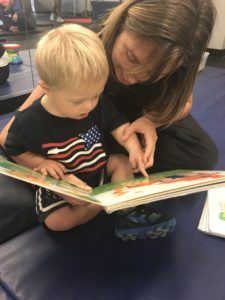 rk and request a speech and language evaluation to determine the specific areas your child is having difficulties with. Visit our website at https://www.abcpediatrictherapy.com to learn more on how to challenge your child.
rk and request a speech and language evaluation to determine the specific areas your child is having difficulties with. Visit our website at https://www.abcpediatrictherapy.com to learn more on how to challenge your child.
Did you know by 3 your child’s diet should typically consist of a variety foods with various textures, sights, temperatures, colors and consistencies? If your child is not eating a variety of fruits, vegetables, meats, and mixed foods (such as mac and cheese or spaghetti), then your child may be a picky eater.
Before addressing feeding, make sure you child’s sensory needs are being meet. Sometimes addressing sensory concerns, such as deficits in proprioceptive input (knowing where your body is in space through heavy work or deep pressure), vestibular input (movements such as swinging), and or tactile input (how your body reacts to touch) can be enough input to help your child try new foods.
Having your child jump on the trampoline or in place, wheelbarrow walk or any animal walk to the dinner table, and or swing prior to eating could be good activities to complete before meal time. Your child could also benefit from the brushing protocol to help with sensory input (contact an occupational therapist at ABC Pediatric Therapy for more information on this protocol). Also, make sure child is okay with getting messy. If s/he is not, it will be beneficial to address this first as well.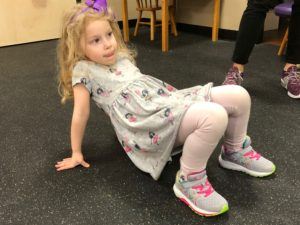
Using shaving cream is one of the easiest messy play activities. At first, make sure your child tolerates being in the same area as the shaving room. Once s/he tolerates being near the shaving cream, have your child begin interacting with it. Put cars, planes, or boats in it and have the child push these around without touching the shaving cream. Slowly begin introducing shaving cream onto the cars and see if your child will continue to touch the cars. Once they do, see if your child will imitate you drawing roads for these cars in the shaving cream. After your child tolerates interacting appropriately with the shaving cream your child is ready to begin trying new foods.
Dr. Kay Toomey developed a feeding hierarchy that has been proven to have great success is regards to sensory picky eaters. Following along the same lines as shaving cream play, Dr. Toomey wants children to be able to tolerate and interact with new foods before actually eating them. If they are not able to tolerate being at the table with the food, then they are not going to be able to interact with it.
To assist with interacting with food, have your child prepare food and use utensils or the container to stir or pour foods/drinks. If your child is having difficulty with using utensils and self-feeding skills, please contact an occupational therapist for additional assistance.
Once your child interacts with foods, the next step on the hierarchy is to smell the foods; have your child lean down or pick it up to smell the food. The next big step is touching foods; go from touching it to his/her fingers to whole hand to chin/nose to lips to teeth to tip of tongue to full tongue to licking it. At this point, reward your child with a preferred food after 1-3 consecutive touches or licks of a non-preferred food. After your child is licking new foods, the next step is to begin tasting them. Initially have him/her take a small bite and designate a spit out jar. Once s/he is able to do this, see if your child can hold the food in his/her mouth for a certain amount of time or even chewing a certain amount of times before spitting out. The next goal would be to chew and swallow with a drink and then independently. Also, at this point, begin rewarding your child with a preferred food after so many bites of a non-preferred food. For example, have your child take 2 small bites of a green bean before being rewarded a preferred gold fish and then repeat this until you are satisfied with how many bites of a non preferred food your child is eating in one sitting.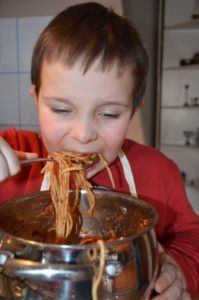
If your child is not making the progress you want, your child may have oral motor deficits. For example, if your child is only eating softer, blander foods, they may have decreased strength. They may also have an immature chew which could make feeding difficult. An occupational therapist would also be able to assess this. A therapist will also be able to determine if your child is having sensitivities to the temperature, texture, flavor, sight, or smell of certain foods which could be inhibiting his/her success.
Please contact ABC Pediatric Therapy for more ideas geared towards your specific needs and if you have any additional questions. Visit our website at www.abcpediatrictherapy.com to find the location nearest you.
Read More Skip to content
Skip to content
